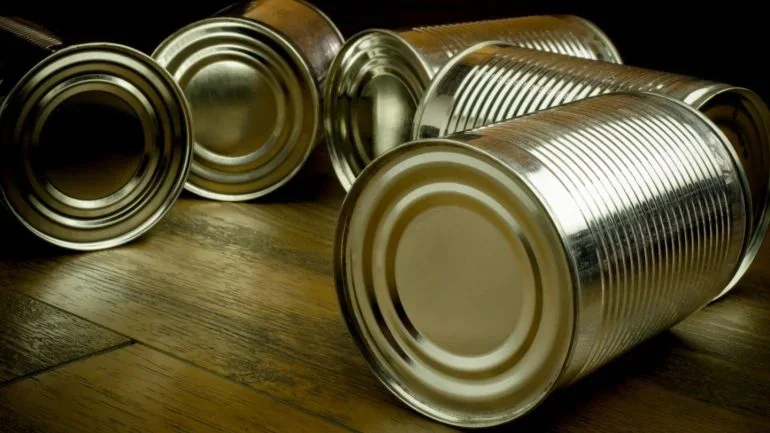From the early days of preserving meats for Napoleon’s army to the sophisticated, recyclable containers used today, steel cans have played a pivotal role in shaping the modern food industry.

The humble steel can, a mainstay in our pantries, has a rich history that dates back over two centuries. Initially introduced in the early 19th century, steel was chosen for packaging due to its strength and durability.
This decision marked a significant innovation in food preservation, enabling foods to be stored and transported over long distances without spoiling.
The origin of steel in packaging is intertwined with the story of Nicolas Appert, the French inventor who discovered that food could be preserved by sealing it in bottles and heating them—an early form of canning.
Despite the initial use of glass, the transition to metal was pivotal. In 1810, the English merchant Peter Durand patented the use of tin-coated steel canisters, revolutionizing the industry.
These early cans were crafted from steel sheets dipped in molten tin, manually soldered shut after being filled. This method, though labour-intensive, was a breakthrough in food preservation, setting the stage for the global food distribution systems we rely on today.
Food canning: the great innovation
The impact of Nicolas Appert’s work and the subsequent development of the tin canister cannot be overstated. Canned food began as a military necessity but quickly became a civilian staple, allowing for safe, long-term storage of a variety of foods from meats and vegetables to fruits and dairy.
The canning process began in Britain when Bryan Donkin and John Hall purchased the canning patent and established the first factory in 1813.
The royal endorsement by King George III boosted the popularity of canned foods, and by the mid-19th century, canning had spread to America and beyond.
Canning technology evolved rapidly; by the late 1800s, machines could produce thousands of cans per hour, a vast improvement over the hand-made methods. This scale of production transformed the food industry, making preserved foods accessible and affordable to the general population.
It also spurred innovations in can design, including the introduction of the two-piece and three-piece cans, which improved the efficiency and safety of canning.
Modern can systems and sustainability
Today’s steel cans are marvels of engineering, designed for durability and sustainability. Modern can-making involves sophisticated techniques such as electrochemical coating and electric seam welding, which have significantly improved the quality and safety of canned goods.
Additionally, contemporary cans may feature lacquers or polymeric linings to prevent corrosion and protect the integrity of their contents.
Steel cans offer several environmental benefits. They are 100% recyclable, and recycling rates in Europe exceed 72%. The recycling process is efficient, preserving the metal’s quality and drastically reducing the environmental footprint associated with can production.
Furthermore, the hermetic sealing of cans protects food from light, oxygen, and moisture, extending shelf life without the need for preservatives and reducing food waste.
The future of steel packaging
Despite competition from newer materials like plastics and aluminium, steel remains a cornerstone of the packaging industry due to its recyclability and the robust protection it offers.
However, the industry must continue to innovate to meet changing consumer demands and environmental standards. The rise of green consumerism and the push towards sustainable packaging solutions pose challenges but also opportunities for the steel can industry.
As we look to the future, the steel can’s ability to adapt will be crucial. Innovations in can design that reduce material use while maintaining functionality, such as easy-open ends and improved recyclability, will help steel maintain its relevance in an increasingly competitive market.
Moreover, understanding and responding to consumer preferences for less processed and fresher food options will be vital.
Steel cans have been an integral part of our food supply chain for over 200 years, demonstrating remarkable durability and adaptability.
As the packaging industry evolves, the resilience and sustainability of steel will continue to be its greatest strengths, ensuring that it remains a vital part of our daily lives.
Source from Packaging Gateway
Disclaimer: The information set forth above is provided by packaging-gateway.com independently of Alibaba.com. Alibaba.com makes no representation and warranties as to the quality and reliability of the seller and products.





 বাংলা
বাংলা Nederlands
Nederlands English
English Français
Français Deutsch
Deutsch हिन्दी
हिन्दी Bahasa Indonesia
Bahasa Indonesia Italiano
Italiano 日本語
日本語 한국어
한국어 Bahasa Melayu
Bahasa Melayu മലയാളം
മലയാളം پښتو
پښتو فارسی
فارسی Polski
Polski Português
Português Русский
Русский Español
Español Kiswahili
Kiswahili ไทย
ไทย Türkçe
Türkçe اردو
اردو Tiếng Việt
Tiếng Việt isiXhosa
isiXhosa Zulu
Zulu